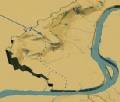Water mills at the island
Article Index
A) THE ORIGIN
 Since the second century mills were on the side of the Gianicolo that from St Peter in Montorio steeply slopes down to the Tiber; they were activated by the fall of the water that the emperor Traiano had derived from the area of the Sabatini mountains (pict. A1).
Since the second century mills were on the side of the Gianicolo that from St Peter in Montorio steeply slopes down to the Tiber; they were activated by the fall of the water that the emperor Traiano had derived from the area of the Sabatini mountains (pict. A1).
During the Goth siege of Rome in 537 AD, Vitige ordered the aqueducts cut in order to prevent the arrival of drinkable water to the city; this lack of water also stopped the operation of the Gianicolo mills. These were reactivated, in a new position, only in the XVII century when Pope Paul V Borghese (1607-1612) built the aqueduct that still has his name (Acqua Paola) conveying water from the lake of Bracciano (pict. A2).
 The forced inactivity of the Gianicolo mills gave birth to the Tiber floating mills: in fact, as Procopio of Cesarea testifies, the Byzantine general Belisario, sent by the emperor Giustiniano to garrison the city, used the river's current to move the first floating mills. He anchored to the banks two boats with a wheel between them; the wheel, activated by the current, drove the millstones located in the boats themselves.
The forced inactivity of the Gianicolo mills gave birth to the Tiber floating mills: in fact, as Procopio of Cesarea testifies, the Byzantine general Belisario, sent by the emperor Giustiniano to garrison the city, used the river's current to move the first floating mills. He anchored to the banks two boats with a wheel between them; the wheel, activated by the current, drove the millstones located in the boats themselves.
The mills had been first located just downstream from Ponte Sisto, the bridge across the only part of the Tiber enclosed by walls on both sides and therefore protected from the military point of view; moreover this location is near the Gianicolo and this made the transport of the millstones easier.
From there the mills grew around the Tiber Island, thus becoming part of the Tiber landscape for more than 1300 years until the construction of the embankments.
From some remnants recovered near the piers of the Ponte Neroniano, near Castel S.Angelo, (one millstone, a chain and some planks of the raft) it has been possible to reconstruct a scale model of the mill (pict. A3).



